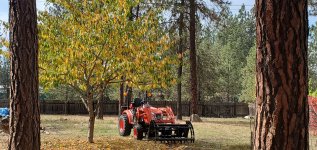Looking to buy my first Kioti tractor for my 26 acre farm. The tasks are bush-hogging 20 acres once per year that includes steep hills, tilling my vegetable garden, 1000 foot gravel driveway maintenance, cutting and hauling wood for winter and just general tractor and loader work.
I think the ck2610 would suit most of my needs except bush hogging.
Subcompact and compact tractors under 3,000 pounds bare weight operate in landscape, kitchen/commercial garden or hobby farm applications on one to ten flat acres.
When considering a tractor purchase bare tractor weight first, tractor horsepower second, rear axle width third, rear wheel/tire ballast fourth.
~~ BUY ENOUGH TRACTOR ~~
Bare tractor weight first
Looking to buy my first tractor for my 26 acre farm that includes steep hills.
CK2610 is too light/narrow/unstable for your topography and tractor applications.
Every tractor producer has at least an economy and deluxe model in the 4,000 pound bare weight category, with a 66" width and 40 to 60 horsepower. These are the mid-weights in the compact tractor category and sell in high unit volumes.
tractor horsepower second
I am assuming I can run a 6ft Bush Hog and might get away with a 7ft.
Mowing once per year you will need a heavy duty Rotary Cutter weighing 1,100 to 1,500 pounds and at least 50 engine horsepower to spin it cutting 5' to 7' tall grass and a year's production of brush.
If contemplating a cab tractor, 60 engine horsepower would be better. The cab weighs ~ 700 pounds ~ and the air conditioning requires several horsepower.
rear axle width third
Tractors are inherently unstable operating on sloped ground. Tractor rear wheel/tire spread, sometimes adjustable, is a critical factor increasing compact tractor stability working sloped or uneven ground. A 6" to 10" increase in rear axle width substantially decreases tractor rollover potential. Tractor width is an approximation of rear axle width.
Small tractor wheels drop into holes, disrupting traction. Larger wheels and tires supplied on heavier tractors bridge holes and ruts, increasing traction. Larger wheels and tires permit higher operating speed over uneven ground by reducing implement bounce and operator perturbation.
rear wheel/tire ballast fourth
To apply 60-horsepower to the ground with an open station tractor you will probably want rear tires filled
50% or 75% with liquid to lower tractor center-of-gravity
and bolt-on wheel weights.
If you are considering a cab tractor the cab weight substitutes for wheel weights.
Tasks include hauling wood for winter and just general tractor and loader work.
With this ballast on the rear wheels you will be able to lift 65% (+/-) of Loader capacity without a Three Point Hitch implement mounted.
